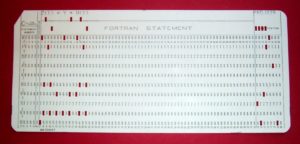
Ancient software developers meticulously punched holes in paper cards to write programs.
In the eons before my graduate career, scientists rarely, if ever, publicly distributed their codes, with authors zealously guarding their coding projects.
But just as I was finishing my PhD, it was becoming common for scientists to make the code they developed as part of a published project readily available on the internet. However, the methods to post code online (at least those I knew about) were pretty clunky.
Nowadays, the infrastructure for posting and sharing code online is robust, mature, and relatively easy to use. Consequently, scientists are creating beautiful code repositories, along with accessible documentation.
Open-sourcing code is becoming ever more important: as codes become more complex and capable, readily available codes with good documentation are critical to support reproducibility, a cornerstone of the scientific process. Moreover, federal funding agencies are starting to require investigators to make their code and data products public.
Unfortunately, since I was one of the last generation of grad students before these repositories were common, I never really learned how to distribute and document code properly.
So as part of an ongoing effort to improve my science output (and as an aide to my future students), I’m going to begin a series of semi-regular blog posts describing my process of learning how to write, document, and post scientific code.
A few caveats upfront:
- I intend to mostly (probably exclusively) write the code in python, which has become (at least in astronomy) the language of choice, so not all of what I write will be generally relevant.
- I was ushered into the Cult of Mac many years ago, so not all of what I write will be relevant for other OS’s. Here again, though, I’ve found anecdotally that most astronomers use Mac.
- This blog series is in no way intended to be comprehensive or rigorous. I’m just planning to describe what I learn as I go along, and what time I can devote will almost definitely not suffice to explain all the details, nuances, or technical aspects that intersect the project.
As to the actual science code I intend to write, several years ago my colleagues and I wrote a paper about ellipsoidal variations induced by massive exoplanets orbiting very close to their host stars. The accompanying code, EVIL-MC was written in IDL, an older language still widely used in astronomy but proprietary and requiring the purchase of an expensive site license.
My plan is to convert that IDL code into a Python package over the next several weeks.
EVIL-MC – Ellipsoidal Variations Induced by a Low-Mass Companion
Tidal distortion (exaggerated) of a star (orange-yellow disk) orbited by planet (white/black disk). The plot below shows the brightness variation of the star due to the tidal distortion.